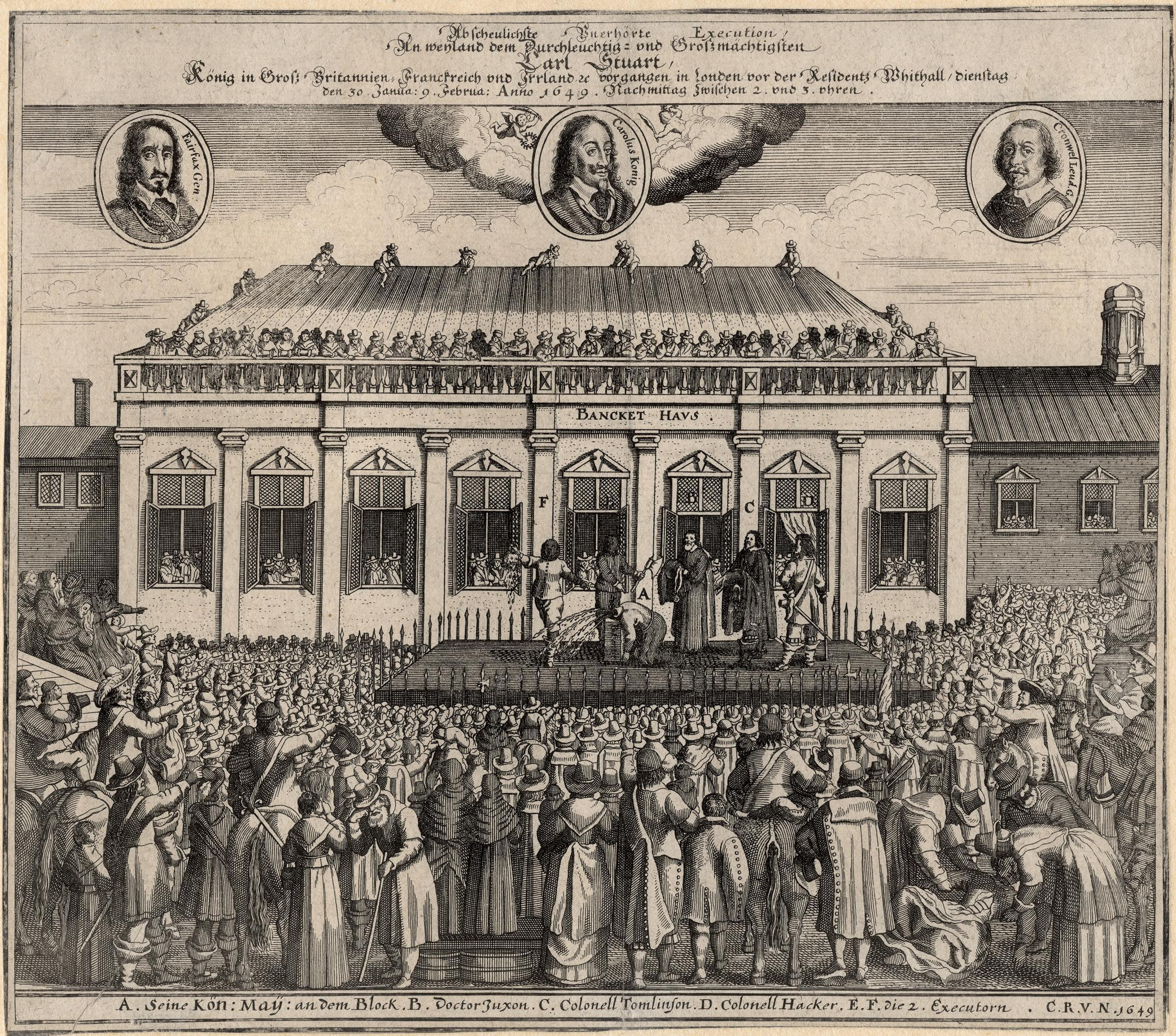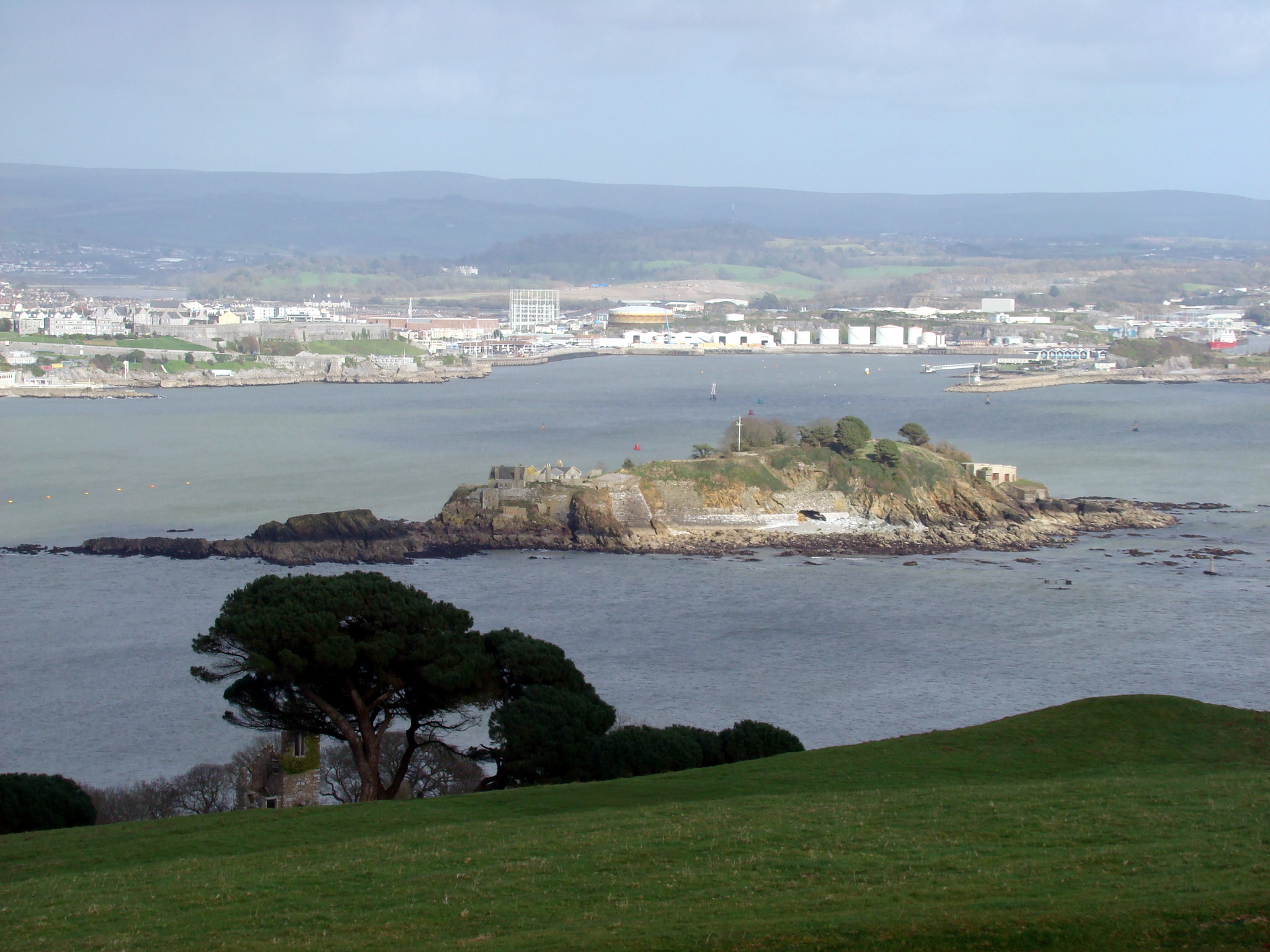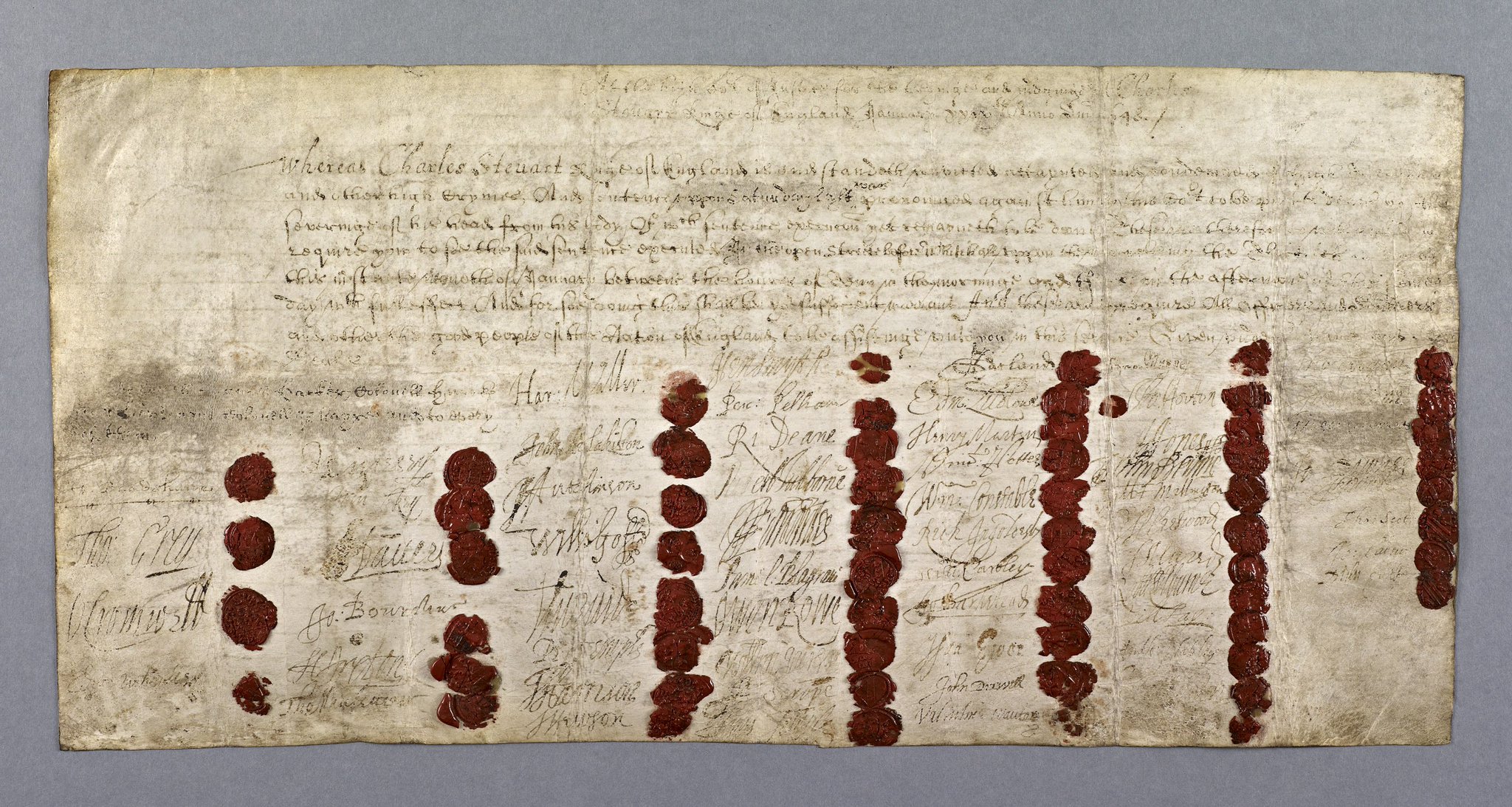|
John Carew (regicide)
John Carew (3 July 1622 - 15 October 1660) was a member of the landed gentry from Antony, Cornwall and MP for Tregony from 1647 to 1653. A prominent supporter of the Fifth Monarchists, a millenarianist religious sect, he backed Parliament and the Commonwealth in the Wars of the Three Kingdoms and approved the Execution of Charles I in January 1649. He held various administrative positions during the Interregnum, including membership of the English Council of State, but was deprived of office and jailed in 1655 for his opposition to The Protectorate. Although aware that as a regicide of Charles I he was likely to be arrested after the 1660 Stuart Restoration, Carew made no attempt to escape. During the trial, he claimed that by signing Charles' death warrant, he was simply complying with a legal Act of Parliament, an argument rejected by the court. He was found guilty of treason and hanged, drawn and quartered on 15 October 1660, two days after his close friend Thomas Harri ... [...More Info...] [...Related Items...] OR: [Wikipedia] [Google] [Baidu] |
Antony, Cornwall
Antony ( kw, Trevanta) is a coastal civil parish and a village in Cornwall, England, United Kingdom. The village is situated on the Rame Peninsula about three miles west of Torpoint and has a shop, a pub and a garage. There are two possible etymologies of Antony: the first is that it is named in honour of St Anthony; the second is that it comes from the Anglicisation of the Cornish Tre- (“farmstead”) and -Anta (personal name) Antony parish is bounded to the north by the tidal River Lynher (also known as the St Germans River) and to the south by the English Channel coast. To the east, the parish is bordered by Torpoint and St John parishes and to the west by Sheviock parish. The parish is in the St Germans Registration District and had a population of 436 at the 2001 census, increasing to 500 at the 2011 census. Apart from the church town, Antony, the only settlement of any size is Wilcove. Scraesdon Fort and Antony House are also in the parish. At the time of Do ... [...More Info...] [...Related Items...] OR: [Wikipedia] [Google] [Baidu] |
Execution Of Charles I
The execution of Charles I by beheading occurred on Tuesday, 30 January 1649 outside the Banqueting House on Whitehall. The execution was the culmination of political and military conflicts between the royalists and the parliamentarians in England during the English Civil War, leading to the capture and trial of Charles I, the King of England, Scotland, and Ireland. On Saturday 27 January 1649, the parliamentarian High Court of Justice had declared Charles guilty of attempting to "uphold in himself an unlimited and tyrannical power to rule according to his will, and to overthrow the rights and liberties of the people" and he was sentenced to death by beheading. Charles spent his last few days in St James's Palace, accompanied by his most loyal subjects and visited by his family. On 30 January, he was taken to a large black scaffold constructed in front of the Banqueting House, where he was to be executed. A large crowd had gathered to witness the regicide. Charles steppe ... [...More Info...] [...Related Items...] OR: [Wikipedia] [Google] [Baidu] |
Drake's Island
Drake's Island is a island lying in Plymouth Sound, the stretch of water south of the city of Plymouth, Devon. The rocks which make up the island are volcanic tuff and lava, together with marine limestone of the Devonian period. For more than 400 years the island was fortified. Early history The first recorded name for the island was in 1135, when it was referred to as St Michael's after the chapel erected on it. At some later date the chapel was rededicated to St Nicholas and the island adopted the same name. From the latter part of the 16th century the island was occasionally referred to as Drake's Island after Sir Francis Drake, the English privateer who used Plymouth as his home port. Even well into the 19th century, maps and other references continued to refer to the island as St Nicholas's Island and it is only in about the last 100 years that this name has slipped into disuse and the name Drake's Island has been adopted. It was from Plymouth that Drake sailed in 15 ... [...More Info...] [...Related Items...] OR: [Wikipedia] [Google] [Baidu] |
First English Civil War
The First English Civil War took place in England and Wales from 1642 to 1646, and forms part of the 1639 to 1653 Wars of the Three Kingdoms. They include the Bishops' Wars, the Irish Confederate Wars, the Second English Civil War, the Anglo-Scottish war (1650–1652) and the 1649 to 1653 Cromwellian conquest of Ireland. Historians estimate that between 15% to 20% of all adult males in England and Wales served in the military between 1639 to 1653, while around 4% of the total population died from war-related causes. This compares to a figure of 2.23% for World War I, which illustrates the impact of the conflict on society in general and the bitterness it engendered. Conflict over the role of Parliament and religious practice dated from the accession of James VI and I in 1603. These tensions culminated in the imposition of Personal Rule in 1629 by his son, Charles I, who finally recalled Parliament in April and November 1640. He did so hoping to obtain funding that ... [...More Info...] [...Related Items...] OR: [Wikipedia] [Google] [Baidu] |
Sir Richard Carew, 1st Baronet
Sir Richard Carew, 1st Baronet (ca. 1580 – 14 March 1643), of Antony in Cornwall, was a British writer and Member of Parliament. Life Carew was the eldest son of the antiquary Richard Carew (1555–1620). He was educated at Oxford, probably at Merton, and studied law at the Middle Temple. He also visited the courts of Poland, Sweden and France, the first two as part of an embassy led by his uncle and the last in attendance on the ambassador, Sir Henry Nevill. He entered Parliament in 1614 as member for Cornwall, and subsequently also represented Mitchell in 1621–2. Carew published several works, including a treatise written to prove that "a warming stone" was "useful and comfortable for the colds of aged and sick people". His most notable work, however, was the ''True and readie Way to learne the Latine Tongue, attested by three excellently learned and approved authours of three nations'', of which he was the English author. This was not published until 1654, well after ... [...More Info...] [...Related Items...] OR: [Wikipedia] [Google] [Baidu] |
Thomas Harrison (soldier)
Major-General Thomas Harrison, baptised 16 July 1616, executed 13 October 1660, was a prominent member of the radical religious sect known as the Fifth Monarchists, and a soldier who fought for Parliament of England, Parliament and the Commonwealth of England, Commonwealth in the Wars of the Three Kingdoms. One of those who approved the Execution of Charles I in January 1649, he was a strong supporter of Oliver Cromwell before the two fell out when The Protectorate was established in 1653. Following the 1660 Stuart Restoration, he was arrested, found guilty of treason as a List of regicides of Charles I, regicide, and sentenced to death. He was hanged, drawn and quartered on 13 October 1660, facing his execution with a courage noted by various observers, including the diarist Samuel Pepys. Personal details Thomas Harrison was Baptism, baptised 16 July 1616, second of four children and only son of Richard Harrison, four times mayor of Newcastle-under-Lyme, and his wife Mary. I ... [...More Info...] [...Related Items...] OR: [Wikipedia] [Google] [Baidu] |
Hanged, Drawn And Quartered
To be hanged, drawn and quartered became a statutory penalty for men convicted of high treason in the Kingdom of England from 1352 under King Edward III (1327–1377), although similar rituals are recorded during the reign of King Henry III (1216–1272). The convicted traitor was fastened to a hurdle, or wooden panel, and drawn by horse to the place of execution, where he was then hanged (almost to the point of death), emasculated, disembowelled, beheaded, and quartered (chopped into four pieces). His remains would then often be displayed in prominent places across the country, such as London Bridge, to serve as a warning of the fate of traitors. For reasons of public decency, women convicted of high treason were instead burned at the stake. The same punishment applied to traitors against the King in Ireland from the 15th century onward; William Overy was hanged, drawn and quartered by Lord Lieutenant Richard Plantagenet, 3rd Duke of York in 1469, and from the reig ... [...More Info...] [...Related Items...] OR: [Wikipedia] [Google] [Baidu] |
Treason
Treason is the crime of attacking a state authority to which one owes allegiance. This typically includes acts such as participating in a war against one's native country, attempting to overthrow its government, spying on its military, its diplomats, or its secret services for a hostile and foreign power, or attempting to kill its head of state. A person who commits treason is known in law as a traitor. Historically, in common law countries, treason also covered the murder of specific social superiors, such as the murder of a husband by his wife or that of a master by his servant. Treason (i.e. disloyalty) against one's monarch was known as ''high treason'' and treason against a lesser superior was '' petty treason''. As jurisdictions around the world abolished petty treason, "treason" came to refer to what was historically known as high treason. At times, the term ''traitor'' has been used as a political epithet, regardless of any verifiable treasonable action. In a civil war o ... [...More Info...] [...Related Items...] OR: [Wikipedia] [Google] [Baidu] |
Act Of Parliament
Acts of Parliament, sometimes referred to as primary legislation Primary legislation and secondary legislation (the latter also called delegated legislation or subordinate legislation) are two forms of law, created respectively by the legislature, legislative and executive (government), executive branches of ..., are texts of law passed by the Legislature, legislative body of a jurisdiction (often a parliament or council). In most countries with a parliamentary system of government, acts of parliament begin as a Bill (law), bill, which the legislature votes on. Depending on the structure of government, this text may then be subject to assent or approval from the Executive (government), executive branch. Bills A draft act of parliament is known as a Bill (proposed law), bill. In other words, a bill is a proposed law that needs to be discussed in the parliament before it can become a law. In territories with a Westminster system, most bills that have any possibility of becoming ... [...More Info...] [...Related Items...] OR: [Wikipedia] [Google] [Baidu] |
Stuart Restoration
The Restoration of the Stuart monarchy in the kingdoms of England, Scotland and Ireland took place in 1660 when King Charles II returned from exile in continental Europe. The preceding period of the Protectorate and the civil wars came to be known as the Interregnum (1649–1660). The term ''Restoration'' is also used to describe the period of several years after, in which a new political settlement was established. It is very often used to cover the whole reign of King Charles II (1660–1685) and often the brief reign of his younger brother King James II (1685–1688). In certain contexts it may be used to cover the whole period of the later Stuart monarchs as far as the death of Queen Anne and the accession of the Hanoverian King George I in 1714. For example, Restoration comedy typically encompasses works written as late as 1710. The Protectorate After Richard Cromwell, Lord Protector from 1658 to 1659, ceded power to the Rump Parliament, Charles Fleetwood and ... [...More Info...] [...Related Items...] OR: [Wikipedia] [Google] [Baidu] |
List Of Regicides Of Charles I
Following the trial of Charles I in January 1649, 59 commissioners (judges) signed his death warrant. They, along with several key associates and numerous court officials, were the subject of punishment following the restoration of the monarchy in 1660 with the coronation of Charles II. Charles I's trial and execution had followed the second English Civil War in which his supporters, Royalist "Cavaliers", were opposed by the Parliamentarian "Roundheads", led by Oliver Cromwell. With the return of Charles II, Parliament passed the Indemnity and Oblivion Act (1660), which granted amnesty to those guilty of most crimes committed during the Civil War and the Interregnum. Of those who had been involved in the trial and execution, 104 were specifically excluded from reprieve, although 24 had already died, including Cromwell, John Bradshaw (the judge who was president of the court), and Henry Ireton (a general in the Parliamentary army and Cromwell's son-in-law). They were gi ... [...More Info...] [...Related Items...] OR: [Wikipedia] [Google] [Baidu] |
The Protectorate
The Protectorate, officially the Commonwealth of England, Scotland and Ireland, refers to the period from 16 December 1653 to 25 May 1659 during which England, Wales, Scotland, Ireland and associated territories were joined together in the Commonwealth of England, governed by a Lord Protector. It began when Barebone's Parliament was dismissed, and the Instrument of Government appointed Oliver Cromwell Lord Protector of the Commonwealth. Cromwell died in September 1658 and was succeeded by his son Richard Cromwell. Richard resigned in May 1659 due to his inability to control either the Army or Parliament. He was replaced by the English Committee of Safety, which dissolved the Third Protectorate Parliament, and reseated the so-called Rump Parliament dismissed by Cromwell in April 1653. This marked the end of the Protectorate, with the Rump acting as the legislature and the English Council of State as the executive. Background Since 1649 until the Protectorate, England ... [...More Info...] [...Related Items...] OR: [Wikipedia] [Google] [Baidu] |








